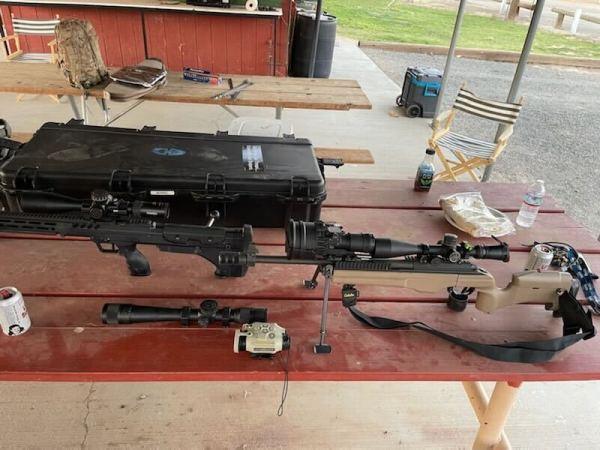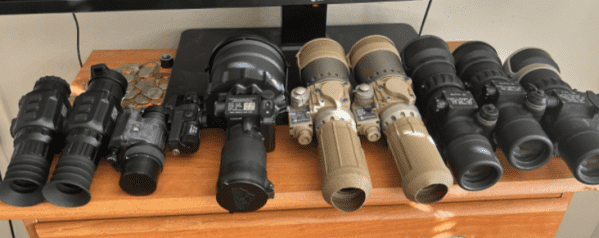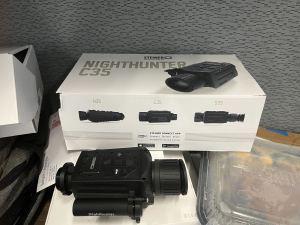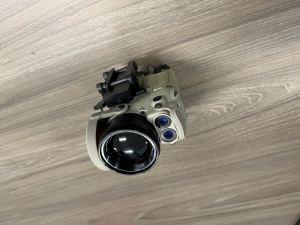This is a pretty general query. Are there specific sights/systems that are better for long-range shooting in the dark? Do any of these sights have useful ways to dial or hold for longer shots? I'd assume that sights that have better resolution would be better for long-range work...but if not, I'd like to know why
You are using an out of date browser. It may not display this or other websites correctly.
You should upgrade or use an alternative browser.
You should upgrade or use an alternative browser.
Long-range accuracy with thermal sights
- Thread starter Wildcat99
- Start date
 Help Support Long Range Hunting Forum
Help Support Long Range Hunting Forum
BallisticsGuy
Well-Known Member
Interesting. This had zero response provided and deserved at least one.
To be brief, thermal stuff (talking current 640 resolution cores) is still hampered by relatively low resolution and so until very recently it's not been great for really long range simply because while detection (there is a thing there) ranges are impressive, recognition (the thing is a of the general type <dog/cat/horse/etc...>) ranges are not and identification (4pt buck vs. spike buck) ranges are somewhat limited. With 384 sensors it was worse. Some 1280 sensors are about to be released into the sporting optics market which will dramatically improve things but until we're seeing closer to 1920 (1080p) resolution it's still going to lag badly in terms of long range positive identification of targets. At long range, thermal is unmatched for detection and NV is unmatched for identification and engagement. Inside about 300m the script is different. Thermal of any quality is frighteningly expensive, vastly more expensive than NV of the same quality level.
Here's a killer long range combo, a Oasys UTM thermal (bottom center tan thing) and a PVS-27 night vision (front optic on the TRG-22). The UTM has an IR laser (not illuminator, laser pointer) built in so it can be used by me or my spotter to detect and point out a target to the night vision equipped rifle. Add something like a 3deg Kiji for added illumination for the NV and you're in as good of shape as one can be (the Kiji is on the Desert Tech rifle which was set up with the UTM when the time came). I used this pair of rifles and optics recently to engage steel plates at 1000m and it was quite easy to do. Pro-tip: Therma-care pads duct taped to the back of the steel plates keep them visible to the thermal for a good long while, without them the plates go ambient temp quickly and end up not visible to the thermal.

Here's an assortment.
2x Bering Hogster dedicated thermals on the far left, then a fusion helmet mount setup with PVS-14 & COTI, then a PVS-27 clip-on NV, then 2x M2124LR clip-on NVs, then 3x PVS-30 clip-on NV's.

Clip-on thermal: Steiner C35 and BAE Oasys UTM aka StalkIR (works as clip-on, monocular, scanner and dedicated). The UTM is the same resolution as the C35 but has fewer features and color palettes.


All my thermals except the COTI are 640 units which is top shelf right now and they're really only usable to about 14x magnification. Lower is better. The NV stuff I can zoom all the way to >25x and while there's plenty of sparkles annoying me, I can still see the target pretty clearly.
To be brief, thermal stuff (talking current 640 resolution cores) is still hampered by relatively low resolution and so until very recently it's not been great for really long range simply because while detection (there is a thing there) ranges are impressive, recognition (the thing is a of the general type <dog/cat/horse/etc...>) ranges are not and identification (4pt buck vs. spike buck) ranges are somewhat limited. With 384 sensors it was worse. Some 1280 sensors are about to be released into the sporting optics market which will dramatically improve things but until we're seeing closer to 1920 (1080p) resolution it's still going to lag badly in terms of long range positive identification of targets. At long range, thermal is unmatched for detection and NV is unmatched for identification and engagement. Inside about 300m the script is different. Thermal of any quality is frighteningly expensive, vastly more expensive than NV of the same quality level.
Here's a killer long range combo, a Oasys UTM thermal (bottom center tan thing) and a PVS-27 night vision (front optic on the TRG-22). The UTM has an IR laser (not illuminator, laser pointer) built in so it can be used by me or my spotter to detect and point out a target to the night vision equipped rifle. Add something like a 3deg Kiji for added illumination for the NV and you're in as good of shape as one can be (the Kiji is on the Desert Tech rifle which was set up with the UTM when the time came). I used this pair of rifles and optics recently to engage steel plates at 1000m and it was quite easy to do. Pro-tip: Therma-care pads duct taped to the back of the steel plates keep them visible to the thermal for a good long while, without them the plates go ambient temp quickly and end up not visible to the thermal.

Here's an assortment.
2x Bering Hogster dedicated thermals on the far left, then a fusion helmet mount setup with PVS-14 & COTI, then a PVS-27 clip-on NV, then 2x M2124LR clip-on NVs, then 3x PVS-30 clip-on NV's.

Clip-on thermal: Steiner C35 and BAE Oasys UTM aka StalkIR (works as clip-on, monocular, scanner and dedicated). The UTM is the same resolution as the C35 but has fewer features and color palettes.


All my thermals except the COTI are 640 units which is top shelf right now and they're really only usable to about 14x magnification. Lower is better. The NV stuff I can zoom all the way to >25x and while there's plenty of sparkles annoying me, I can still see the target pretty clearly.
bb204
Well-Known Member
Youtube should answer your questions
vedauvoo
Well-Known Member
Appreciate a very good and relevant question Wildcat99. It does deserve and answer, and you got a good one from BallisticsGuy.
Thanks for a very illuminating (pun intended) review. Solid and creative ideas. I too would like to get better educated in night vision options for coyote hunting here in the West. You gave us a lot of good info in your reply. Gives me a solid foundation to start my search for useful practical NV gear.
Thanks for a very illuminating (pun intended) review. Solid and creative ideas. I too would like to get better educated in night vision options for coyote hunting here in the West. You gave us a lot of good info in your reply. Gives me a solid foundation to start my search for useful practical NV gear.